Breaking Barriers
Typically, we define arts learning as learning to draw, dance, act, or play an instrument, but those technical skills are often the setting for learning other fundamental skills like self-advocacy, communication, and collaboration. Here Kathleen Hill shares two instances that illustrate how the arts become a stage where young people develop their thoughts and insights, articulating them for public audiences.
Across the United States, there are countless communities in which students face opportunity gaps due to a lack of in-school, arts education initiatives. Many districts spread the limited numbers of arts educators and teaching artists across multiple schools, resulting in arts education being a rich, but rare, rather than regular and sustained occurrence. The costs to artistry and creativity are obvious, but such a stingy approach to arts learning also robs young people of important opportunities to make their voices heard, share what’s on their mind, raise questions, and bring their full selves to the table.
Increasingly, as communities navigate these realities, they are actively casting a wider net, folding in teachers, teaching artists, parents, and students themselves, with traditional leaders such as school principals, boards, and committees, to forge the path ahead for arts education.
While each of these perspectives is incredibly important, the intentional inclusion of youth voices feels particularly prescient after the onset of the COVID-19 pandemic. Everything familiar about their educational experience was upended in 2020 and the path forward seemed unknowable. Many young people and their allies chose to meet the moment, becoming advocates for and agents of the futures they wanted to see.
This blog highlights two experiences that illustrate how opportunities in, through, and beyond the arts encourage young people to become advocates for themselves and their communities:
- Through the creation of a student-devised theatrical project, The Shiners, the Owsley County community in Kentucky celebrated youth experiences within their community. Developed before, during, and after the COVID-19 pandemic, the work was supported by Partners for Rural Impact (PRI) and encouraged the high schoolers to reflect on the highs and lows of life in Appalachian Kentucky as well as the pride that they feel for their home.
- Through the inclusion and activation of youth ambassadors at the Designing New Futures for Arts Integration Convening, Crystal Bridges Museum of American Art ensured that young people were involved in forging new pathways for themselves and their peers in the arts education sector. Hosted in October 2022, the convening was the culmination of an exploratory phase of work for the museum to consider the national arts integration landscape as well as its potential roles in it.
The Shiners: A Play about Youth Voice
Partners for Rural Impact (PRI) uses a place-based, cradle-to-career approach to respond dynamically to the needs of each community within its network – ranging from K-12 education, dental clinics, flood relief, teaching artists networks, rural library networks, and more.
With the support of PRI, teaching artists, teachers, and high school students in the Kentucky county of Owsley came together to capture, hone, and tell their stories on stage in a full-length and festival-length production that also took on an unexpected life as a radio play during the COVID-19 pandemic.
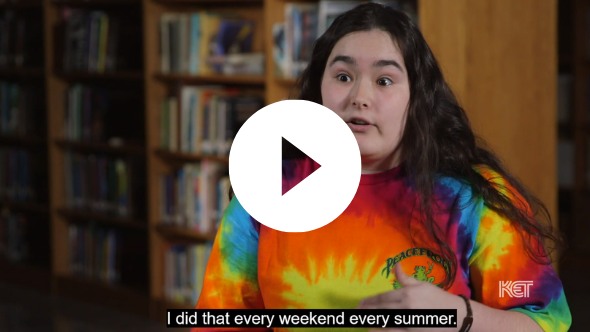
The work was an intensive collaboration between students, a local arts teacher, Stevi Nolan, and local teaching artists, Bob Martin and Judy Sizemore.
Judy Sizemore, a PRI collaborator for many years, was instrumental in the execution of “Our Creative Promise”, a Promise Zone and Promise Neighborhood project in 10 southeastern Kentucky counties as well as the creation of a teaching artist directory for the region. The video below captures some of the stories from Our Creative Promise.
One of her notable projects was the creation of “Where I’m From” poems. Inspired by the poem of the same title by Kentucky poet, George Ella Lyons, Judy encouraged the students to take an asset-based approach to writing about their communities. Check out a few poems from students at Hazard High School in Perry County here.
Bob Martin had previously supported the Owsley County community in developing HomeSong 1-3. Developed with support from PRI, “the HomeSong project exemplifies the collaborative nature of [The Owsley] County community as well as residents’ desire to ‘tell our own story.’ Artists, schools, non-profit organizations, members of the business community, and others worked together to develop the scripts and stage the musical productions with an inter-generational cast of residents mostly lacking prior theatrical experience. Many participants reflect that this project, by and about their community, had a significant and lasting impact on them personally and on their county.”
To get a sense of the spirit of HomeSong, watch the clip of the opening song below or, if you have the time, consider watching the full production of HomeSong 1 here.
Regional Youth Arts Summit
In the fall of 2018, PRI, hosted a regional youth arts summit. It was designed to engage young people in PRI’s collective impact efforts to improve arts education in the region. During the end-of-day reflection session, young people shared that they admired and appreciated HomeSong, but they did not feel like their perspectives were represented and they wanted to create something that more accurately reflected the complexities and challenges of their modern lives.
Bob, Judy, and Stevi were all present at the summit. Rather than ignoring the students’ constructive critiques, they leaned into them and began to work together to conceptualize how they might build on the foundation of HomeSong and create another outlet for young people in the region – a place where they could safely talk about the highs and lows of their experience growing up in Appalachian Kentucky.
Creating The Shiners
In the fall of 2019, Stevi tasked her high school arts classes with developing the characters and writing the dialogue in the play The Shiners. When her students first learned of the project, they all thought Stevi was joking with them. Their doubts and wonderings grew when they learned that they were not only going to write the play, but they were going to perform and produce it too, telling Stevi that “she had lost her brain.”
The students did eventually warm to the project, making it their own. In an interview, Stevi spoke of the ways in which students who would never open up in class were suddenly engaged: “There was one specific (student) … having him in a normal classroom, he probably wouldn’t have wanted to do a whole lot, but he got to do something like this and he just came alive. He got to tell his story.”
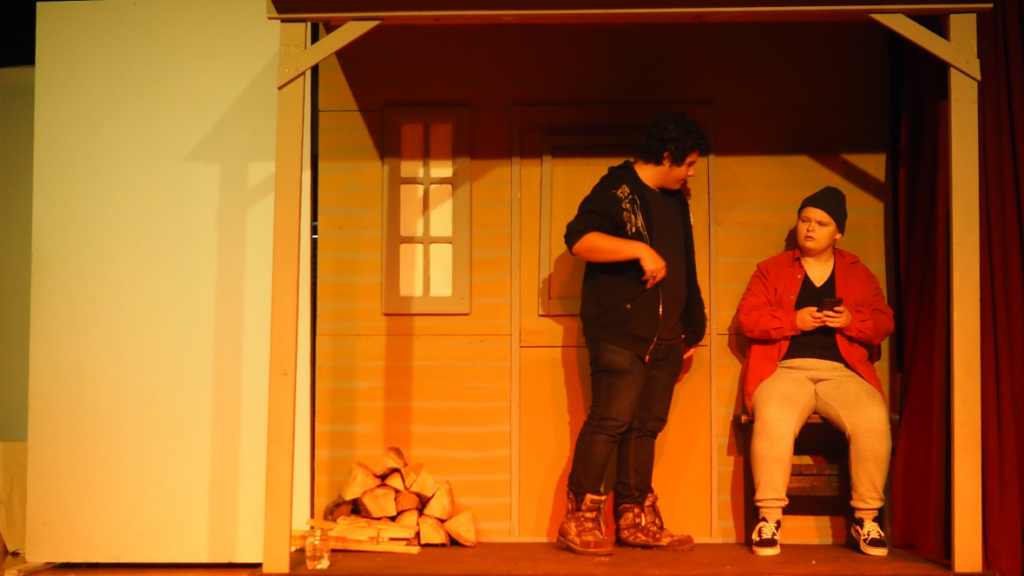
The Shiners focuses on two young men, Cletus and Reggie. After the loss of their grandfather, the boys struggle to find new direction without his guidance, wondering whether they’ll be able to keep their tight-knit, but growing family together. An uncle even tempts one of them into joining an underground moonshine business. Ultimately, they find a new way forward with help from unexpected sources.
The student-led play also boasts original music from a local high school band and a variety of original pieces which are featured in a talent show at a county fair in Act 2.
As Stevi and her students were gearing up to present the play in spring 2020, COVID-19 halted the physical production. Stevi and her collaborators adjusted quickly, moving the show to a radio play format which featured drawings from teachers and students from Owsley County Schools.
When school resumed in-person and audiences were able to gather once more, Stevi moved forward with the full production of the play. They had to recast several roles as students had graduated, but new students were willing and able to step in.
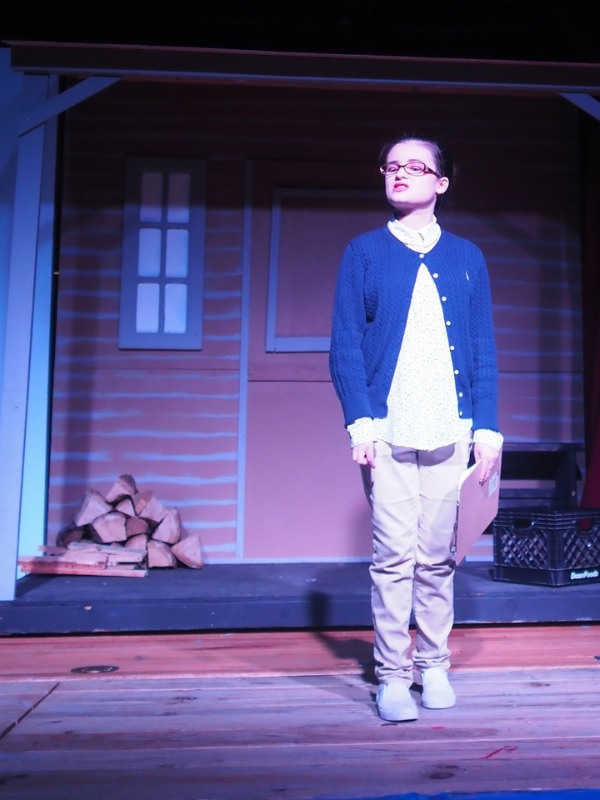
One such student was Erin who first participated in the production as a freshman. She was a writer and a featured performer during the talent show at the county fair. Her involvement in the play expanded during her junior and senior years to a supporting role as Miss Anna, a representative of Child Protective Services who worked with Cletus and Reggie to ensure they could stay together after the passing of their grandfather. In reflecting on her expanded involvement, Erin said, “I’m really glad that I got to be Miss Anna because I feel like she plays a huge role and (helps) other people during rough times. I went through some family issues too. (Miss Anna) is always there to fix it and is a very hard worker—just like me.”
In reflecting on her experience with The Shiners, from devising to performing for the county and at the Kentucky Theater Association (KTA), the statewide theater festival for high schools in Kentucky, Erin expressed her gratitude:
“The Shiners has been really great for me. I’ve learned so much from The Shiners and it’s taught me a lot of lessons … because while The Shiners was getting started, I had been going through some things: depression, family issues, losing somebody. It was a very emotional time. I went through it for four years, but what really kept me going was The Shiners.
“… And look where we are today! From a piece of paper into this wonderful play called The Shiners what we created. … It brought so many people to tears, it brought a lot of messages to a lot of people, some that we do know and some that we don’t know. Going through with KTA, even if we didn’t win, we still got a message through about hope. And I feel like the actual winning is getting that message across, not winning the trophy … because we still got our message across—we got our voices spoken out. That is a huge thing about this play and I don’t think any other play is going to beat it.”
To get a sense of the project, watch the clip of a promotional reading from 2019 below or, if you have the time, watch the audio project featuring drawings or the full stage production.
Designing New Futures for Arts Integration: A Convening with Youth at the Table
In spring 2022, Crystal Bridges Museum of American Art (CBMAA) launched a project to explore contemporary possibilities for arts integration – both in the United States as well as at the museum: “Windgate Education Excellence Through the Arts.” The exploratory phase aimed to address how the arts can foster students’ learning, creativity, engagement, and emotional wellbeing.
CBMAA engaged a team of consultants from WolfBrown and Creative Generation to identify and convene a diverse group of established and emerging leaders in the arts integration field. Their challenge was to collaboratively envision new futures for arts integration and how Crystal Bridges and other museums might use these future strategies to improve the equity and quality of K-12 educational experiences.
The exploratory phase of the work culminated in a two-day convening at Crystal Bridges on October 3-4, 2022. The list of 55 attendees included high school and college students, artists, teachers, teaching artists, school administrators, after-school arts programs, museum staff, foundations, and government officials, as well as researchers and experts in education policy and entrepreneurship. Attendees represented 43 institutions across 20 states, as well as Washington, D.C. and Canada. Nearly 10 percent of the attendees were youths and recent alumni of arts integration programs, and another 10 percent were teaching artists.
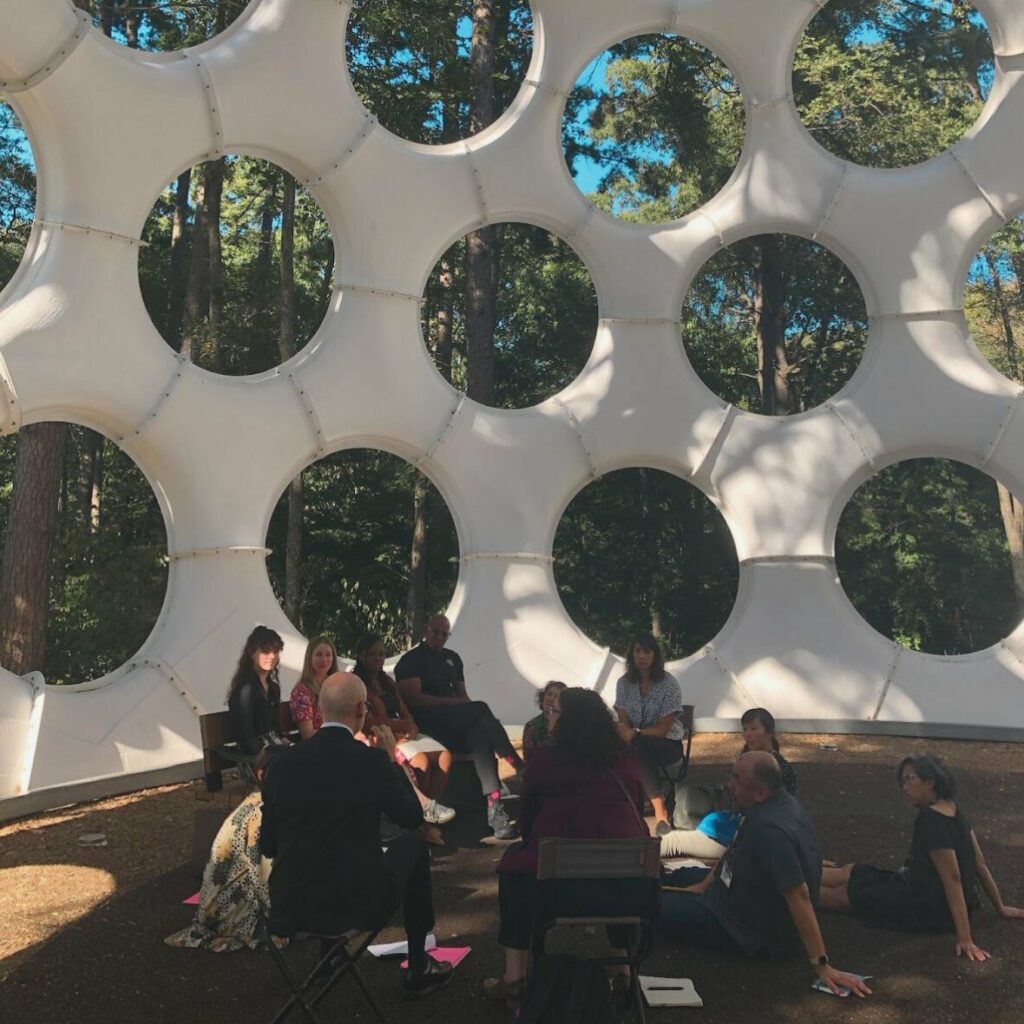
Throughout the convening, youth attendees were not idle onlookers. They were all invited to complete the same pre-convening trainings as their adult counterparts, lean into group discussions to speak about their experiences and present critical questions of current practices, and share out findings from breakout groups with the larger group of attendees. More often than not, these young people were encouraged and empowered by their adult counterparts to take chances and risks in stepping up to speak for themselves and their groups.
In an interview, one youth ambassador from the Emerson Collective reflected about their arts integration experiences.
“My arts integration story is from my freshman year of high school. I was taking a Harlem Renaissance class where we were studying the work of Langston Hughes. We were tasked with recreating one of his poems—kind of mimicking his style, but replacing the content with our own. I chose my favorite poem of his which is ”Theme for English B.” I really dove into it. I didn’t think of myself as a poet my freshman year of high school, but I really just dove into expressing my identity and what it meant for me as a biracial student in a predominantly white school and the experiences that I’ve had. I really just put it all on paper—stuff that I don’t find myself telling people normally.
“The lesson I learned was that it was super liberating for me. I was surprised at how good it felt to say these things, especially in the style of a poem. It just flowed and felt very natural. It felt like my medium.
“I would hope that as we move forward with education and curriculum reform that the decision makers in these processes see the power and the untapped potential that poems and other arts forms have for students like me who are maybe struggling to express their identity and come into themselves in these public social settings and the ability to use art as a way for students to express themselves and feel comfortable being who they are.”
Over the course of the exploratory convening, an emerging, central theme was to “center youth voices in planning and execution” as their reflections and insights are critical and vital.
Crystal Bridges began this commitment within the design of the convening and hopes to carry it forward with the creation of new arts integration programming at the museum. In the coming year, the museum will share tools and findings from the convening as well as prepare for their new wave of programming.
How Does this Work Break Barriers?
Empower Youth during Times of Transition and Change
For young people, the transition from education settings like high school and college to pathways beyond them involves several critical questions and decisions, including whether and how they maintain their connections to arts and culture.
- Will I continue to perform or create after I graduate from school?
- What resources will my college or training program provide me with to continue performing or creating?
- How much will it cost to maintain private lessons and studio time if I am not an arts major or minor?
- Will I have time to participate in an arts ensemble when I have to balance coursework and a job?
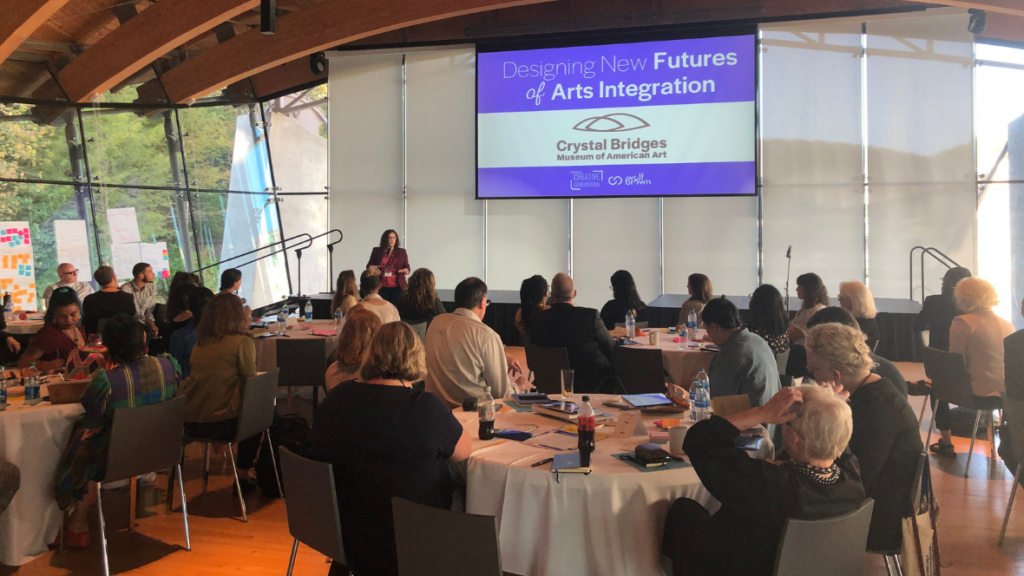
Involving youth in expanded roles within the arts and culture sector like The Shiners and the convening at Crystal Bridges is critical in helping them see that there are numerous ways in which the arts can enrich their lives and their communities beyond presenting finished products (e.g., orchestral concerts, plays, or art shows). Expanded experiences provide learning opportunities and skills-training for young people who, when offered access and opportunity, will not only see but benefit from the ways in which the arts can support things like health and wellness, community investment and development, and community pride.
The process of incorporating youth voices into these experiences is an intentional one and takes time. It takes time to build relationships, to spool them up on strong practices in collaboration and communication. It takes time to encourage them to come out of their shells, embrace being authentic, and not worry about what other people might think.
While this process may delay the deliverable or extend the timeline, the dividends are enormous because it is a direct investment in young people’s continued involvement in and allyship of the arts and culture sector. Whether they step into roles as artists, audiences, administrators, or decision makers, they know the deep value that the arts can play in their own and others’ lives.
What expanded experiences for young people in the arts and culture sector are you familiar with? Send me an email.
I’d love to learn more and potentially feature those experiences in an upcoming newsletter.

About Our Work and Collaborators
About Creative Generation

Creative Generation believes that youth create change. They are a values-driven global collective that collaborates with young creatives and those who cultivate their creativity to take local actions towards global changes in pursuit of a more just world. Founded in 2019, Creative Generation operates five signature programs: The Campaign for a Creative Generation, the Institute for Creative Social Transformation, The Academy for Creative Leadership, the Incubator for Creative Impact, and the Foundation for a Creative Generation.
About Partners for Rural Impact

For over 25 years, Partners for Rural Impact (PRI), formerly known as Partners for Education at Berea College, has been supporting the communities of Appalachian Kentucky through place-based, cradle-to career-initiatives that empower rural leaders and communities to accelerate educational outcomes for all students.
What began as an initiative in one county now serves 50,000 young people a year across 31 counties in Appalachian Kentucky, in addition to working with communities in Arkansas, Missouri, New Hampshire, South Carolina, and Texas.
Today, PRI works in rural communities by
- Addressing the program gap found in rural places to ensure students have equitable access to resources,
- Building the capacity of rural schools and communities to be data-driven and equity-focused, and
- Aligning local, regional, and national systems to ensure student success.
About Crystal Bridges Museum of American Art
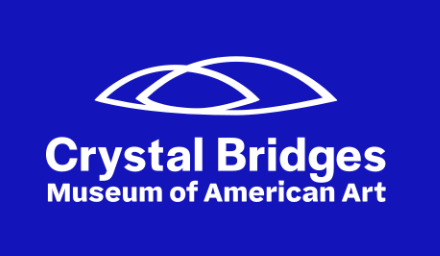
The mission of Crystal Bridges Museum of American Art is to welcome all to celebrate the American spirit in a setting that unites the power of art with the beauty of nature. Founded by philanthropist and arts patron Alice Walton, Crystal Bridges is a public non-profit charitable organization. The museum opened on November 11, 2011, and welcomes all with free admission.
Crystal Bridges provides year-round programming for all ages, including lectures, performances, classes, and continuing education for K-12 teachers. More than 50,000 schoolchildren visit the museum each year as part of the Willard and Pat Walker School Visit Program, which offers schools reimbursement for out-of-pocket expenses associated with a school field trip, including transportation costs, substitute teachers, and lunch. An initiative to develop high-quality online learning opportunities for students and teachers is currently underway.
About Our Work
Crystal Bridges Museum of American Art selected the collaborative team from Creative Generation and WolfBrown to design and lead an exploratory phase of work for “Windgate Education Excellence Through the Arts,” an arts integration initiative. The project addressed how the arts can foster learning, creativity, and engagement as well as academic, social, and emotional wellbeing for students in a post-pandemic education landscape. Through this work, the three organizations hosted the Designing New Futures for Arts Integration Convening, connecting them with practitioners and youth across the United States, including a team from Partners for Rural Impact.

This post is a part of the Breaking Barriers focus of our Amplifying Creative Opportunities newsletter. Read other Breaking Barriers-themed posts.
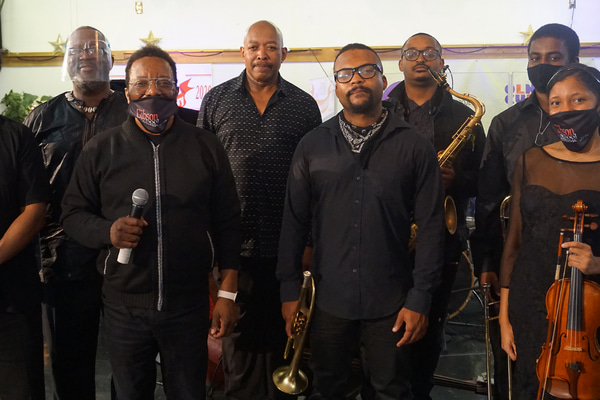
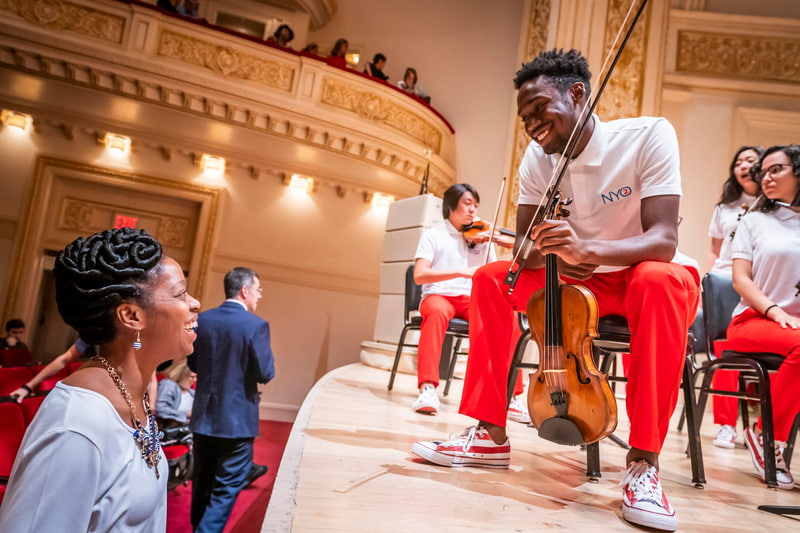
Here is a piece by Abigale Franco and Dr. Dennie Palmer Wolf titled “Youth Orchestras as Opportunity Structures” from our second issue.


